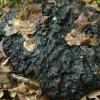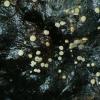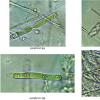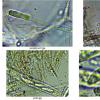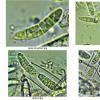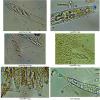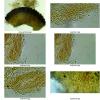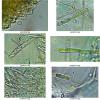
28-12-2025 12:08
Margot en Geert VullingsThis possible Karstenia was found on the bark of d

21-12-2025 21:32
Pol DebaenstHello, Garden, Burgweg 19, Veurne, BelgiumOn 10/1

26-12-2025 21:19
Arnold BüschlenPithyella chalaudii Priou. Ist als Bryoparasit in

21-12-2025 09:32
Hello.A tiny ascomycete found embedded in wood in

18-12-2025 21:17
Pol DebaenstThe identification took me to Byssonectria deformi

24-12-2025 17:08
Hulda Caroline HolteHello, I have found this propoloid ascomycete on
Asco sur Inonotus dryadeus
Bernard CLESSE,
16-08-2017 19:20
 Bonsoir à tous,
Bonsoir à tous,Hier j'ai trouvé, sur vieux polypore pourri (Inonotus dryadeus) au pied d'un chêne, cet ascomycète.
a) paraphyses hyalines, cylindriques, septées, à contenu réfringent
b) spores subfusiformes, arquées, remplies de guttules et triseptées à maturité : 18-24x5-6,5
c) asques IKI-, à crochet à la base
d) poils serrés, ± subulés, arrondis au sommet, à contenu réfringent
Une idée ?
Bernard
Kosonen Timo,
17-08-2017 09:03

Re : Asco sur Inonotus dryadeus
Hi Bernard,
I think we are somewhere in the world of "bald" discos with strong IKI reaction in the paraphyses (the same VB visible in your photos turns amber). Phaeohelotium/Calycina/Trabinella - just shooting names (from Zotto's folders). Maybe Zotto has a good suggestion for this big-spored species. Maybe this one also falls into "Pezizellaceae", otherwise the big picture is still unclear here as far as I know...
Timo
I think we are somewhere in the world of "bald" discos with strong IKI reaction in the paraphyses (the same VB visible in your photos turns amber). Phaeohelotium/Calycina/Trabinella - just shooting names (from Zotto's folders). Maybe Zotto has a good suggestion for this big-spored species. Maybe this one also falls into "Pezizellaceae", otherwise the big picture is still unclear here as far as I know...
Timo
Bernard CLESSE,
18-08-2017 23:31

Re : Asco sur Inonotus dryadeus
Hi Timo,
Thank you for your opinion !
I have done some photos of the asci that are well IKI + and not IKI- as I had previously reported. Apparently, the reaction does not come on.
Thank you for your opinion !
I have done some photos of the asci that are well IKI + and not IKI- as I had previously reported. Apparently, the reaction does not come on.
I also observed the excipulum that seems typical. I see clavate cells.
Best regards,
Bernard
